- Home
- »
- Ausbildung/Seminare
- »
- Seminare
- »
- Archiv 2019
Seminare Physios/Tierärzte
Im Folgenden sind alle Kurse die ich im In- und Ausland gebe nach Veranstaltung mit den jeweiligen Veranstaltungsorten und Daten gelistet.
Für Fragen rund um die Veranstaltung bitte ich Euch den jeweiligen Veranstalter direkt zu kontaktieren.
Archiv 2019
cmt-Seminare 2019
1. Kompaktkurs canine Manuelle Therapie der Extremitätengelenke
23.01.2019 – 23.01.2019 Trentino (Südtirol)
09.07.2019 – 14.7.2019 Geretsried, Sarah Mergen
Datum steht noch nicht fest Saarbrücken, Nina Reiber
01.11.2019 – 05.11.2019 Swisttal, Susanne Schmitt
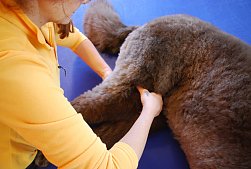
- Grundlagen der Manuellen Therapie
- Prinzipien der orientierenden
- Prinzipien der spezifischen Untersuchung
- Anatomie und Biomechanik von Hüft-/Knie- und Ellbogengelenk
- Untersuchung und Behandlung von HG, KG, EBG (Bewegungspalpation, joint play, Provokation)
- Untersuchung und Behandlung der zugehörigen Weichteilstrukturen (Funktionsmassage, Längs-/Querdehnung, deep friction nach Cyriax)
- Anatomie und Physiologie der Neuralstrukturen
- Untersuchung und Behandlung von N. Ischiadicus und N. Femoralis
- Anatomie und Biomechanik Schultergelenk, Unterschenkel/Unterarm, Tarsal- und Carpalgelenken*
- Untersuchung und Behandlung von EBG, Unterschenkel/Unterarm, Tarsal und Carpalgelenken (Bewegungspalpation, joint play, Provokation)
- Untersuchung und Behandlung der zugehörigen Weichteilstrukturen (Funktionsmassage, Längs-/Querdehnung, Deep Friction nach Cyriax
- Anatomie und Physiologie der Neuralstrukturen
- Untersuchung und Behandlung von N. radialis, N.medianus, N. Ulnaris
Anmeldung: bitte direkt bei den jeweiligen Fortbildungszentren anmelden.
Maximale Teilnehmerzahl: 12 (bitte Hunde mitbringen)
Dozent: Sabine Hárrer, Human-/Tierphysiotherapeut (ZVK), int. MT, MTT, MLD, cmt, cnd, canine Osteopathie
2. canine Manuelle Therapie der WS
WS 1:
03.05.2019 – 04.05.2019 Swisttal, Susanne Schmitt
- Spezielle funktionelle Anatomie und Biomechanik der Wirbelsäule,
- Palpation und Anatomie in vivo
- Grundlagen der Gelenkmechanik
- Neurophysiologische Grundlagen
- Gelenkspezifische Untersuchung,
- Befundinterpretation und Behandlung der Wirbelsäule (Mobilisation, high velocity techniken)
WS 2:
24.08.2019 – 25.08.2019 Swisttal, Susanne Schmitt
- Weiterführende Techniken der WS Behandlung (high velocity techniken)
- Weichteiltechniken der zugehörigen Muskulatur von HWS, BWS, Rippen, LWS
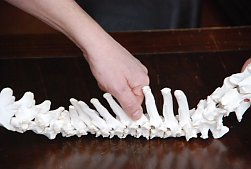
Anmeldung: bitte direkt bei den jeweiligen Fortbildungszentren anmelden.
Maximale Teilnehmerzahl: 12 (bitte Hunde mitbringen)
Dozent: Sabine Hárrer, Human-/Tierphysiotherapeut (ZVK), int. MT, MTT, MLD, cmt, cnd, canine Osteopathie
canine Neurodynamik 2019
Modul 1:
23.02.2019 – 24.02.2019 FBZ, Karlsdorf-Neuthard
07.03.2019 – 08.03.2019 Bad Wildungen
01.05.2019 – 02.05.2019 Swisttal, Susanne Schmitt
05.07.2019 – 07.07.2019 bei Sarah Mergen, Geretsried
Modul 2:
09.03.2019 – 10.03.2019 Bad Wildungen
22.08.2019 – 23.08.2019 Swisttal, Susanne Schmitt
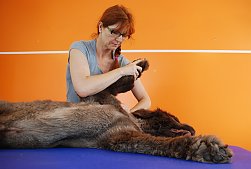
Kursinhalt:
In diesem Kurs lernt der Therapeut Verklebungen der neurogenen Strukturen zu erkennen, zu behandeln und von nicht neurogenen Strukturen zu differenzieren. Der Therapeut ist in der Lage vor allem das periphere NS mit verschiedenen Techniken zu untersuchen und zu behandeln.
Inhalt – Modul 1:
- Neurobiomechanik
- Untersuchung und Behndlung des Pl. brachialis, des Pl. lumbalis, der Hirnhäute und der Leistenregion
- Untersuchung und Behandlung folgender Nerven:
- N. Suprascapularis
- N. Musculocutaneus
- N. Axillaris
- Nn. Subscapularis
- N. Iliohypogastricus cranialis et caudalis
- N. Ilioinguinalis
- N. Genitofemoralis
- N. Cutaneus femoralis lateralis
- N. Obturatorius
- Indikationen und Kontraindikationen
- Palpation und manuelle Mobilisation der peripheren Nerven
- Auswertung der Behandlungsresultaten
Inhalt – Modul 2:
- Untersuchung und Behandlung der Dura mater
- Untersuchung und Behandlung des Pl. brachialis und des Pl. lumbalis
- Untersuchung und Behandlung der folgenden peripheren Nerven:
- N. Radilis
- N. Medianus
- N. Ulnaris
- N. Femoralis
- N. Saphenius
- N. Ischiadicus (N. Peroneus et N. Tibialis)
- Indikationen und Kontraindikationen
- Palpation und manuelle Mobilisation der peripheren Nerven
- Auswertung der Behandlungsresultaten
Anmeldung: bitte direkt bei den jeweiligen Fortbildungszentren anmelden.
Maximale Teilnehmerzahl: 12 (bitte Hunde mitbringen)
Dozent: Sabine Hárrer, Human-/Tierphysiotherapeut (ZVK), int. MT, MTT, MLD, cmt, cnd, canine Osteopathie
Palpation 2019
05.05.2019 – 06.05.2019 Swisttal, Susanne Schmitt*
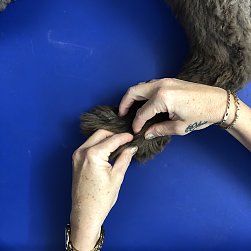
Dieses Praxis-Seminar richtet sich an angehende oder praktizierende Tiertherapeuten, die Sicherheit in der manuellen Untersuchung von Körperstrukturen erhalten möchten. Eine exakte Orientierung am Bewegungsapparat des Tieres ist Grundvoraussetzung für eine erfolgreiche Befundung und anschließende Behandlung.
Der Kurs beschäftigt sich mit dem Thema „Was genau palpiere ich wo und wie“. Nach einem kurzen Exkurs in die Anatomie werden wir Knochenpunkte, Gelenke, Muskulatur, Gefäße und Nerven unserer Hunde palpieren.
Ziel des Kurses ist es sich sicher auf der „Landkarte“ Hund zu bewegen
Kursinhalt:
- Exkurs Anatomie
- Palpation der Muskeln und deren Septen
- Palpation von Knochenpunkten
- Palpation der Gelenke, Ligamente und Gelenkspalte
- Palpation von Gefäßen
- Palpation von Nerven
Anmeldung: bitte direkt bei den jeweiligen Fortbildungszentren anmelden.
Maximale Teilnehmerzahl: 12 (bitte Hunde mitbringen)
*Dozent: *Sabine Hárrer, Human-/Tierphysiotherapeut (ZVK), int. MT, MTT, MLD, cmt, cnd, canine Osteopathie
canine manuelle Lymphdrainage 2019
06.09.2019 – 08.09.2019 Geritsried, Sarah Mergen
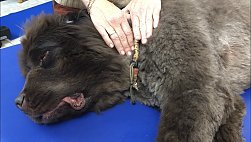
Die manuelle Lymphdrainage ist aus dem Berufsbild des Tierphysiotherapeuten nicht mehr wegzudenken. Durch spezielle Grifftechniken, die zart und langsam ausgeführt werden kann der Lymphfluss angeregt werden oder ein Lymphstau im Gewebe abgebaut werden. Somit ist das Einsatzgebiet der caninen manuellen Lymphdrainage vielfältig:
- post-OP um einen Flüssigkeitsstau im Gewebe (z.B. Hintergliedmaße nach KB-OP) abzudrainieren
- bei irritierten, peripheren Nerven im Foramen intervertebrale oder an Engstellen (z.B. N. radialis unter dem M. supinator)
- bei jeglichem Geschehen, das zu einem Flüssigkeitsstau im Gewebe führt
- bei Narbenbildung
- bei Erkältung
Kursinhalte:
- Aufbau des Lymphsystems
- Transportwege
- Einsatzgebiet der caninen manuellen Lymphdrainage
- Grifftechniken
- Behandlungsaufbau
- Kontraindikationen
Anmeldung: bitte direkt bei den jeweiligen Fortbildungszentren anmelden.
Maximale Teilnehmerzahl: 12 (bitte Hunde mitbringen)
Dozent: Sabine Hárrer, Human-/Tierphysiotherapeut (ZVK), int. MT, MTT, MLD, cmt, cnd, canine Osteopathie
STAAR-Conference 2019
New Jersey, USA
canine Neurodynamik 24.04.2019 – 26.04.2019
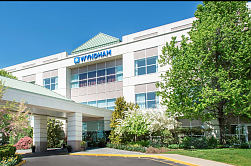
Workshop Description: This course is intended to give the participants an introduction into canine neurodynamics and how to examine the most common nerves and their functions. The lecture will cover basic neuro-biomechanics, including peripheral nerve examination and why dysfunctions of the dura mater can cause peripheral nerve problems and affect meningeal structures, and how nerve adhesions can lead to extremity dysfunctions. The lab will consist of examination techniques of the N. ischiadicus, N. femoralis, N. radialis, N. medianus and N. ulnaris, as well as nerve palpation, and nerve mobility testing. Treatment options will be discussed.
Learning Objectives:
- Participants will be able to identify adhesions of neurogenic structures and how to differentiate them from joint or muscular disorders.
- Participants will learn how to exam nerves.
- Participants will be instructed how to detect and treat nerve dysfunctions (hands-on and video).
Course Outline
Lecture
- Introduction to neurodynamics
- Mobility dysfunctions of peripheral nerves
- Differentiation between nerve and joint/muscle dysfunctions
- Dysfunctions of the dura mater
Lab
- Manual nerve assessment
- Treatment of nerve dysfunctions
- Treatment of tissue boundary layers
- Designing a treatment plan
Workshop 1: Canine Neurodynamic: Testing and Treating the membranes oft he cranium, the dura mater, brachial plexus and lumbal plexus
Day/Time: Thursday, 9:00am-6:30pm
Instructor: Sabine Hárrer, PT, MT (OMT), LDT, MTT
Course Description:
canine neurodynamic 1:
- Basics (theory)
- examination and treatment of the membranes of the cranium (Tentorium cerebellum, falx cerebelli, falx cerebellum)
- examination and treatment of the dura mater
- examination and treatment of plexus brachialis
- examination and treatment of plexus lumbalis
Learning Objectives Participants will be able to identify adhesions of neurogenic structures and how to differentiate them from orthopedic or muscular disorders Participants will learn how to exam the membranes oft he cranium, Dura mater, brachial plexus and lumbal plexus. Participants will be instructed on how to detect and treat dysfunctions (hands-on and video)
Course Outline
Lecture Introduction to neurodynamics Mobility dysfunctions of the membranes oft he cranium and the brachial and lumbal plexus. Differentiation between nerve and joint/muscle dysfunctions Dysfunctions of the dura mater
Lab Manual nerve assessment Treatment of nerve dysfunctions Treatment of tissue boundary layers Designing a treatment plan
This course is intended to give the participants an introduction into canine neurodynamics and how to examine the membranes oft he cranium, the dura mater and the brachial as well as the lumbal plexus. The lecture will cover basic neuro-biomechanics, including Dura mater examination and why dysfunctions of the dura mater cause peripheral nerve problems and affect meningeal structures. The course will examine how nerve adhesions can lead to extremity dysfunctions. The lab will consist of examination, palpation and treatment the membranes oft he cranium, the dura mater and the brachial plexus as well as the lumbal plexus as
Workshop 2: Canine Neurodynamic: Testing and Treating the Nerves of the Thoracic Limb
- examination and treatment of plexus brachialis
- examination and treatment of suprascapular nerve
- examination and treatment of musculocutaneus nerve
- examination and treatment of axillaris nerve
- examination and treatment of subscapularis nerve
- examination and treatment of radial nerve
- examination and treatment of median nerve
- examination and treatment of ulnar nerve
Workshop 3: Canine Neurodynamic: Testing and Treating the Nerves of the Pelvis Limb
- examination and treatment of plexus lumbalis
- examination and treatment of lateral cutaneus nerve
- examination and treatment of femoral nerve
- examination and treatment of saphenius nerve
- examination and treatment of obturatorian nerve
- examination and treatment of siatic nerve
Hopital Vétèrinaire De Pierrefonds
canine Neurodynamik 2019, Montreal, Kanada

Workshop Description: This course is intended to give the participants an introduction into canine neurodynamics and how to examine the most common nerves and their functions. The lecture will cover basic neuro-biomechanics, including peripheral nerve examination and why dysfunctions of the dura mater can cause peripheral nerve problems and affect meningeal structures, and how nerve adhesions can lead to extremity dysfunctions. The lab will consist of examination techniques of the N. ischiadicus, N. femoralis, N. radialis, N. medianus and N. ulnaris, as well as nerve palpation, and nerve mobility testing. Treatment options will be discussed.
Learning Objectives:
- Participants will be able to identify adhesions of neurogenic structures and how to differentiate them from joint or muscular disorders.
- Participants will learn how to exam nerves.
- Participants will be instructed how to detect and treat nerve dysfunctions (hands-on and video).
Course Outline
Lecture
- Introduction to neurodynamics
- Mobility dysfunctions of peripheral nerves
- Differentiation between nerve and joint/muscle dysfunctions
- Dysfunctions of the dura mater
Lab
- Manual nerve assessment
- Treatment of nerve dysfunctions
- Treatment of tissue boundary layers
- Designing a treatment plan
Workshop 1: Canine Neurodynamic: Testing and Treating the membranes oft he cranium, the dura mater, brachial plexus and lumbal plexus
Instructor: Sabine Hárrer, PT, MT (OMT), LDT, MTT
Course Description:
- Basics (theory)
- examination and treatment of the membranes of the cranium (Tentorium cerebellum, falx cerebelli, falx cerebellum)
- examination and treatment of the dura mater
- examination and treatment of plexus brachialis
- examination and treatment of plexus lumbalis
Learning Objectives Participants will be able to identify adhesions of neurogenic structures and how to differentiate them from orthopedic or muscular disorders Participants will learn how to exam the membranes oft he cranium, Dura mater, brachial plexus and lumbal plexus. Participants will be instructed on how to detect and treat dysfunctions (hands-on and video)
Course Outline
Lecture Introduction to neurodynamics Mobility dysfunctions of the membranes oft he cranium and the brachial and lumbal plexus. Differentiation between nerve and joint/muscle dysfunctions Dysfunctions of the dura mater
Lab Manual nerve assessment Treatment of nerve dysfunctions Treatment of tissue boundary layers Designing a treatment plan
This course is intended to give the participants an introduction into canine neurodynamics and how to examine the membranes oft he cranium, the dura mater and the brachial as well as the lumbal plexus. The lecture will cover basic neuro-biomechanics, including Dura mater examination and why dysfunctions of the dura mater cause peripheral nerve problems and affect meningeal structures. The course will examine how nerve adhesions can lead to extremity dysfunctions. The lab will consist of examination, palpation and treatment the membranes oft he cranium, the dura mater and the brachial plexus as well as the lumbal plexus as
Workshop 2: Canine Neurodynamic: Testing and Treating the Nerves of the Thoracic Limb
- examination and treatment of plexus brachialis
- examination and treatment of suprascapular nerve
- examination and treatment of musculocutaneus nerve
- examination and treatment of axillaris nerve
- examination and treatment of subscapularis nerve
- examination and treatment of radial nerve
- examination and treatment of median nerve
- examination and treatment of ulnar nerve
Workshop 3: Canine Neurodynamic: Testing and Treating the Nerves of the Pelvis Limb
- examination and treatment of plexus lumbalis
- examination and treatment of lateral cutaneus nerve
- examination and treatment of femoral nerve
- examination and treatment of saphenius nerve
- examination and treatment of obturatorian nerve
- examination and treatment of siatic nerve
15723 Pierrefonds Blvd, Pierrefonds, QC H9H 3×6, Kanada
day/time: coming soon
